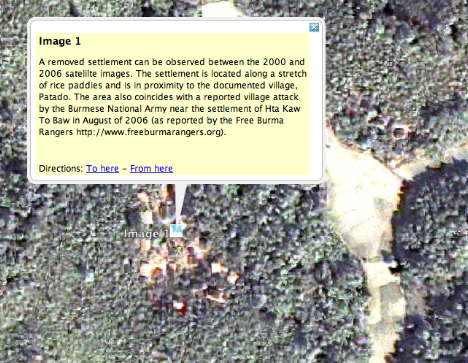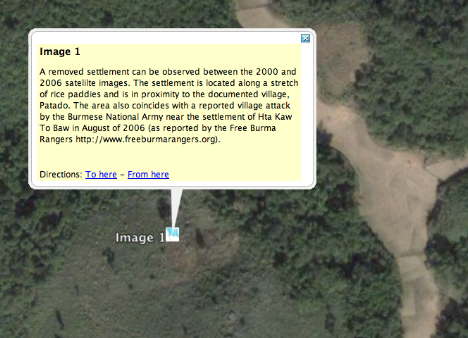Burma has been in the news this week, but the human rights abuses being perpetrated by Burmese government forces have been ongoing for a generation. In one region, a separatist movement by the Karen people is habitually repressed by attacking and displacing civilian villages on the grounds that they provide support to separatist fighters.
Such tactics are evident on satellite imagery, and now an initiative by Lars Bromley at the American Association for the Advancement of Science (AAAS) has commissioned before-and-after imagery to show the effects of this ongoing ethnic cleansing program.
The AAAS has written a news release linking to the detailed report containing the imagery, which in turn link to a KML file that georeferences those images on top of Google Earth:
Before (Ikonos, Nov 11, 2000):

After (Quickbird, June 24, 2007):

This isn’t the first time that geospatial technology has been used to document human rights violations. Back in June 2006, the AAAS documented the razing of villages in Zimbabwe, and later also the effect of the 2006 war in Lebanon and the ongoing crisis in Darfur. In April 2007, a layer documenting the Darfur crisis prepared by the US Holocaust Memorial Museum and others became a default layer in Google Earth. North Korea has also been extensively annotated. What all these initiatives make clear is that when it comes to documenting the effects of human rights abuses on large populations, satellite imagery can do valuable service in lending credence to reports of violations and in raising public awareness.
The AAAS report on Burma makes for interesting reading, especially regarding what’s next:
AAAS also is investigating the possibility of developing a Web-based geospatial information portal of the Burma conflict. This portal would, to the extent possible, summarize attack-related information and provide access to satellite imagery to a select group of NGOs. Lastly, AAAS will begin making available, via a Web site, its tools for roughly matching village name spellings with coordinates and available satellite imagery. Ideally, all these tools together will improve information-sharing regarding the conflict in Burma, and improve collective understanding and planning efforts. […]
Other organizations are encouraged to consider this content as available for any future media project using Google Earth. For example, a Burma Google Earth product modeled after the Darfur layers released by the U.S. Holocaust Memorial Museum might be ideal.
Matching village names as used by their inhabitants to the transliterated names on maps was also one of the main challenges in making the USHMM Darfur layer. Having such collaborative tools exist on the web would greatly facilitate the work of human rights organizations everywhere.
Less encouraging, once again, is how the media reported the AAAS announcement of the report this Friday. Because it was timely, the mainstream media gave it welcome prominence (See the NYT, MSNBC) but once again, every online news item I read fails not only to link on to the KML layer, but also the detailed report. The geoweb is not going to be transformative until the average news reader starts consuming georeferenced information published to a geobrowser, and that won’t happen until and unless news organizations start linking to such content. Bloggers link to source material all the time; why can’t journalists, especially if the “story” is about the release of georeferenced satellite imagery?
Timesonline had the kml link at the end:
http://www.timesonline.co.uk/tol/news/world/asia/article2552329.ece
My hope is that news organizations will link to GE or at least embed maps for ALL stories, even if there is no added info.
It also wouldn’t be hard for CNN to publish a kml network link that shows the current location of whatever story was on CNN at the moment, sort of as a CNN home companion, ideally with placemarks containing the stories themselves.
If it weren’t for media consolidation (staff cutting, less competition), I think this would have happened a long time ago.
http://www.freeburmarangers.org/
Well done by the Times!
Free Burma!
International Bloggers’ Day for Burma on the 4th of October
International bloggers are preparing an action to support the peaceful revolution in Burma. We want to set a sign for freedom and show our sympathy for these people who are fighting their cruel regime without weapons. These Bloggers are planning to refrain from posting to their blogs on October 4 and just put up one Banner then, underlined with the words “Free Burma!”.
http://www.free-burma.org
Does anyone know what the series of 30 or so strange buildings north west of the new military capital are? Some are still being completed. They can be seen at the edge of the high resolution data for that area.